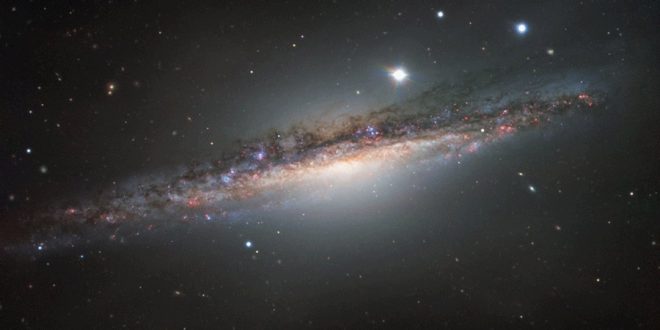Giant telescope captures images of galaxy NGC 1055, sister of the Milky Way.
The spiral galaxy is located roughly 55 million light-years from Earth in the constellation of Cetus (the Sea Monster). A recent image from the European Southern Observatory’s (ESO) Very Large Telescope captures NGC 1055 from the side, showing it as a bright, colorful streak of gas, dust and countless twinkling stars.
The new observations also suggest that NGC 1055 is up to 15 percent wider than Earth’s own Milky Way galaxy (whose diameter is about 100,000 light-years), according to a statement from ESO.
Generally, the dust and whirling arms of spiral galaxies such as the Milky Way look flat when seen edge-on, because they are oriented differently toward Earth. However, the new image of NGC 1055 offers a 3D view and showcases the galaxy’s overall shape.
“When seen edge-on, it is possible to get an overall view of how stars — both new patches of star birth and older populations — are distributed throughout a galaxy, and the ‘heights’ of the relatively flat disc and the star-loaded core become easier to measure,” ESO officials wrote in the statement Wednesday (March 1).
“Material stretches away from the blinding brightness of the galactic plane itself, becoming more clearly observable against the darker background of the cosmos,” the officials added.
Using this edge-on perspective, astronomers found evidence of warping, as NGC 1055’s disc bends and twists across the galaxy’s core. This unusual structure is likely the result of an interaction with the nearby galaxy Messier 77, ESO officials said. The gravitational force behind this kind of interaction can distort the galaxies’ shapes, as their stars, gas, and dust merge over millions of years, they added.
The newly released image was captured by the FOcal Reducer and low dispersion Spectrograph 2 instrument mounted on Unit Telescope 1 of the Very Large Telescope, which is located at ESO’s Paranal Observatory in Chile.
Agencies/Canadajournal

 Canada Journal – News of the World Articles and videos to bring you the biggest Canadian news stories from across the country every day
Canada Journal – News of the World Articles and videos to bring you the biggest Canadian news stories from across the country every day

